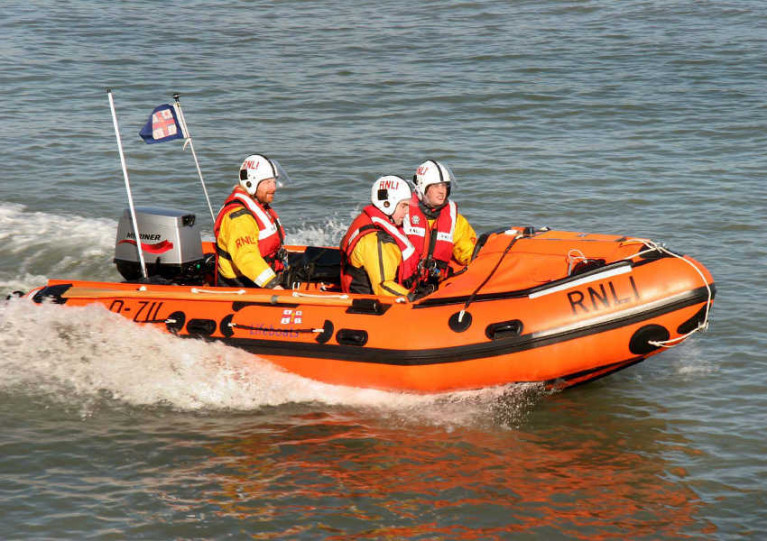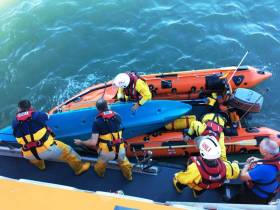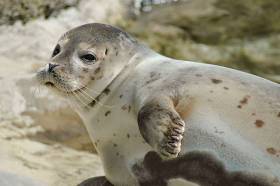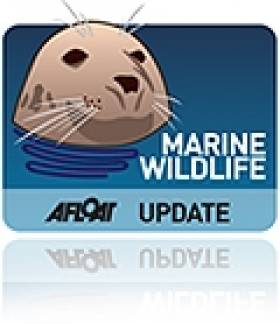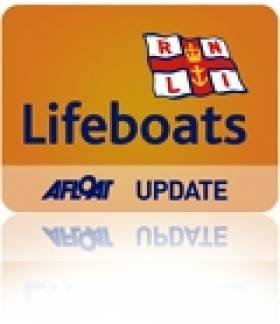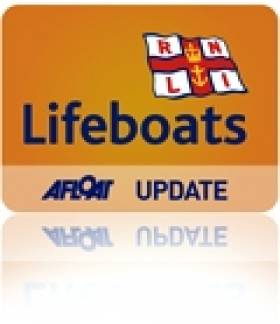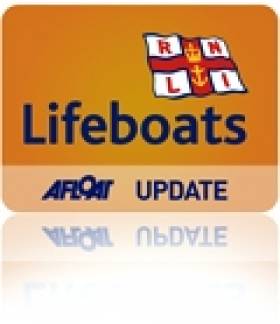Displaying items by tag: Courtown
Larne RNLI’s volunteers launched to the aid of three people in difficulty off the Antrim coast between late Monday evening (17 May) and early Tuesday morning (18 May).
Both the all-weather and inshore lifeboats were requested to launch around 11pm following a report that a man had fallen on rocks and sustained possible wrist and head injuries in the Ballygally area of the East Antrim coast.
The all-weather lifeboat Dr John McSparron went alongside providing support and helping to illuminate the area for the Larne Coastguard and Northern Ireland Ambulance Service crews already on scene.
With the location of the casualty presenting access issues, he was moved to the inshore lifeboat in a basket stretcher and ferried to the slipway near Ballygally beach where he was transferred to the waiting ambulance.
Just a couple of hours later, the lifeboat crew were called out again to assist two sailors on a 35ft yacht on passage from Argyll with reported engine failure some 15 nautical miles off Larne Harbour.
After checking both sailors were safe and well, the volunteers set up a tow for the vessel to its destination of Carrickfergus Marina, where it was secured for maintenance.
Larne RNLI’s deputy launching authority Philip Ford-Hutchinson described the night as a busy one “with little rest between callouts”.
He added: “The first call demonstrated great teamwork between the RNLI, Larne Coastguard and the Northern Ireland Ambulance Service.
“Callouts like these are something that our volunteer crew regularly train for and the skill and professionalism was evident last night. We wish the gentleman a speedy recovery.”
 Arklow RNLI’s all-weather lifeboat takes a stricken fishing vessel under tow on Friday 14 May | Credit: RNLI/Arklow
Arklow RNLI’s all-weather lifeboat takes a stricken fishing vessel under tow on Friday 14 May | Credit: RNLI/Arklow
Elsewhere, Arklow RNLI and Courtown RNLI launched their respective all-weather and inshore lifeboats to reports of a fishing vessel in danger of sinking near Courtown last Friday morning (14 May).
As the Courtown crew arrived on scene, they found a number of other fishing boats attempting to tow the stricken vessel to safety as its crew managed to stem the flow of water on board.
Arklow RNLI then set up their own tow to bring the casualty vessel into Arklow Harbour amid calm seas.
Mark Corcoran, Arklow RNLI community safety sfficer, said: ”It’s great to see all of the various agencies working together helping to save lives at sea and in our communities.
“Thankfully this callout became lower risk due to the actions of the vessel’s own crew.”
Courtown Lifeboat Called to Assist After Small Boat Runs Aground
Courtown RNLI braved difficult sea conditions to recover a small boat that ran aground north of Cahore Harbour in Co Wexford yesterday, Sunday 21 February.
Lifeboat volunteers were called at 3.45pm to the vessel with three on board, which had reportedly lost power around a mile north of Cahore Harbour at Glasscarrig Beach.
Courtown RNLI reports that arriving at the scene in the inshore lifeboat, its crew learned that the boat had lost power soon after launch, and had subsequently washed up on the beach and rocks.
All three occupants had managed to get safely ashore in the meantime. But recovery of their boat proved difficult due to the choppy conditions at sea.
A tow line was eventually secured and the boat was towed back to Cahore Pier by Cahore Inshore Rescue, who also attended the scene.
Speaking after the callout, Courtown RNLI lifeboat operations manager Sam Kennedy said: “It was great to see that the three people managed to get to shore safely.
“Our crew responded readily today and adhered to all Covid-19 guidelines currently in place at Courtown RNLI.”
The inshore lifeboat on this callout was helmed by Peter Browne with crew members Fergus Slevin and Cormac Kinsella.
#RNLI - Courtown’s RNLI lifeboat volunteers feature in the new series of Saving Lives at Sea on BBC Two this week.
Now on its third year, Saving Lives at Sea puts the spotlight on the RNLI’s army of unpaid volunteers around the UK and Ireland who out their lives on the line to save others.
Using footage shot on the crews’ own cameras, the maritime TV series takes viewers into the heart of the action, capturing the unpredictable work of the RNLI in unique detail.
The 10-part third season begins tonight (Tuesday 21 August) at 8pm, following the crew of Salcombe lifeboat station in Devon on two vital callouts — to a fisherman pulled to the bottom of the sea in his own fishing gear, and a devastating fire on a boat 15 miles out in the English Channel.
Over 200 miles away in the waters off Anglesey, meanwhile, the crew of Moelfre station uncover a story of survival and heroism as they go to the rescue of a father and his 13-year-old son missing at sea.
Courtown RNLI in Co Wexford will be a part of episode two this Thursday evening (23 August) at 8pm on BBC Two, as they face one of their most challenging missions — keeping a teenage girl with suspected spinal injuries immobile and afloat until she can be airlifted for treatment.
#Rescue - The Arklow lifeboat joined Courtown RNLI and the Irish Coast Guard in a multi-agency rescue on Friday evening (11 August) after a teenage girl fell from an inflatable ‘doughnut’ being towed by a jet ski in Courtown Harbour.
Once on scene, around a mile east of Ardamine Beach south of Courtown, the Arklow lifeboat volunteers assisted their Courtown colleagued who were already in the water dealing with the casualty, a 13-year-old girl with suspected spinal injuries.
Arklow RNLI worked to clear the area of other vessels to allow for a safe airlift by the Waterford-based coastguard helicopter Rescue 117.
In the process, they picked up three other casualties — kayakers who had entered the water to assist in the rescue but found themselves adrift.
Independent.ie and The Irish Times have more on the story.
Seal Rescue Centre Seeks Sponsors
#MarineWildlife - The Seal Rescue Centre in Courtown is appealing for new sponsors to fund supplies for the marine wildlife in its care, as the Gorey Guardian reports.
The sanctuary recently took on its first sponsor in Gorey’s Amber Springs Hotel, which now has its name displayed over one of the 12 kennels available.
More than 60 seals are being kept at the Co Wexford centre that has a busy winter period taking in rescued seals and seal pups, the latest of them brought in from Clogherhead in Co Louth at the end of January.
But the Seal Rescue Centre is also celebrating successful releases back into the wild of seals it has treated — like Nala, an orphaned seal found in distress at Union Hall in West Cork last October, according to the Southern Star.
Dutch Step In To Keep Seal Rescue Centre Open
#MarineWildlife - Courtown's seal sanctuary has been saved from closure after Dutch counterparts stepped in to help fill a key vacancy over maternity leave.
As the Wexford People reports, Sonja Ciccaglione has now been seconded as temporary manager of Seal Rescue Ireland's Wexford base.
And she joined the group's volunteers at the latest release of rehabilitated seals last weekend.
Luckily for the staff-strapped marine wildlife centre, it's a quiet period with only a couple of seals remain in residence – but donations from the public are always welcome.
Courtown Sees Off Latest Rescue Seals
#MarineWildlife - After last week's good news of a seal pup rescue in Northern Ireland, on the other end of the island a number of similar rescue seals got a fresh start for the New Year.
The Gorey Guardian reports on the release of five seals - named Flotsam, Misty, Skipper, Marina and Ariel - by the Courtown Seal Rescue Centre from the Wexford town on 2 January.
The marine mammals in question were picked up from beaches along the east coast from Ballinesker to Rosslare in various states of injury and distress, and rehabilitated over a number of months.
In the case of Skipper in particular, it was cheering to see him return to the waves fighting fit months after he was discovered emaciated with propeller wounds.
The Gorey Guardian has more on the story HERE.
Lucky Escape For Three Men In A Boat Thanks To Donaghadee RNLI
#RNLI - Three young men had a lucky escape on Sunday evening (3 August) when their small boat began sinking on a pleasure trip from Ballywalter to Donaghadee.
The Irish Coast Guard was alerted to the emergency by one of the boat’s crew members using his mobile phone. He was unsure of his position but reported that the party was somewhere between the Copeland Islands, Bangor and Donaghadee.
Heading in the direction of Belfast Lough, Donaghadee RNLI’s all-weather lifeboat Saxon spotted the vessel – a small orange and white speedboat – and within a few minutes was on the scene.
The three casualties were taken aboard and checked for injury or illness. One had fallen into the water and was beginning to suffer from the effects of the cold.
The speedboat was taken under tow to Donaghadee Harbour. The survivors were brought to the boathouse where they were given hot drinks and after warming up they were collected by relatives.
“This could so easily have been a tragedy," Donaghadee RNLI coxswain Philip McNamara. "Even in calm conditions the sea is a dangerous place.
"All those who enjoy boating should ensure they have lifejackets and safety equipment before they set out. Always check the weather and ensure someone knows what you are doing and when you expect to return.”
In other lifeboat news, Courtown RNLI launched yesterday afternoon (4 August) to a call from two people on a speedboat who were unable to get their boat started and were drifting onto the beach at Ardamine.
After some manoeuvrings the lifeboat crew managed to tow the 19ft speedboat off the sand and back to the harbour in Courtown, were it was discovered that the fan belt had broken in the engine.
Lough Derg Lifeboat Investigates Drifting Dinghy
#RNLI - Lough Derg RNLI's lifeboat launched on Sunday 1 June to investigate reports of a dinghy adrift off Parker's Point on the Clare shore.
At 6.35pm Valentia Coast Guard requested Lough Derg RNLI to investigate reports of a dinghy adrift in open water in the direction of Meelik Bay.
The lifeboat launched three minutes later with helm Eleanor Hooker and crew Ger Egan and Liam Knight on board. Winds were south-westerly Force 3 to 4 and visibility was fair to good, with frequent line squalls.
Coastguard staff gave the lifeboat crew the co-ordinates at which the dinghy was seen, and a description of the boat. The lifeboat reached the location at 7pm and its crew calculated the drift of the dinghy given its size and the wind direction.
On the shore where the dinghy would have landed, a remote location, the RNLI crew could detect an oar being raised and lowered above the reeds, and went to investigate.
It was soon discovered that a local family of five a fishing trip had seen the dinghy and had towed it to shore, where they safely moored it up. The dinghy did not have an engine and there was no evidence of it having been occupied.
Reporting these findings to Valentia Coast Guard, the lifeboat was stood down and returned to station. Later, the owner of the dinghy made contact with Valentia explaining that his tender had broken free from his cruiser in rough weather earlier in the day.
Lough Derg RNLI deputy launching authority Pat Garland said: "A small craft adrift in the middle of the lake has implications other than the boat might have slipped its moorings, which, thankfully, is the case today."
He commended the boat users on the lake for their "diligence on their watch and for reporting the dinghy".
In another false alarm, Donaghadee’s all-weather Lifeboat Saxon launched around 8.00pm on Saturday 31 May after reports of an object in the water off the coast of the Copeland Islands in Co Down.
A witness described what appeared to be people in the water, and the lifeboat was on scene within 15 minutes - to find nothing more than a bunch of helium-filled party balloons that had come down in the sea.
Lifeboat coxswain Philip McNamara said: "While this was a preventative operation, the lifeboat volunteers prefer to attend at an early stage to avoid any risk to life. An object in the water can be a danger to shipping.”
The same day saw Courtown RNLI's volunteer lifeboat launch to the aid of a small angling boat that had suffered engine failure.
However, the launch was delayed by a car and boat trailer that had been parked across the launching winch area for the lifeboat.
Thankfully the lifeboat – crewed by Glen Deacon, Fergus Slevin and Robert Ireton Jr – was launched by other means and was quickly alongside the casualty, towing the boat back into harbour.
Courtown lifeboat operations Manager Sam Kennedy said: "We urge people not to park across the launching area or to block up the slipway in Courtown. We were lucky that this was not a more serious incident and the delay didn't cause loss of life."
Courtown Lifeboat Rescues Driver From Submerged Dump Truck
#RNLI - Courtown RNLI's lifeboat was launched on Saturday evening (1 March) to reports of a dump truck submerged off Ardamine Beach in the Wexford town.
The driver of the 25-tonne dump truck had managed to get out of the cab and onto the bonnet before the tide completely submerged it.
He was rescued from the top of the vehicle by the lifeboat crew of Glen Deacon, Áine Stafford and James Mahon and taken back to the lifeboat station.
The truck was later recovered from the sea at the next low water.


























